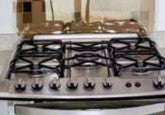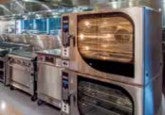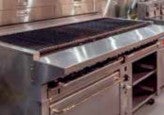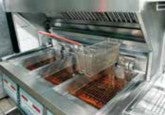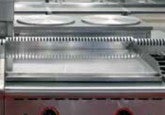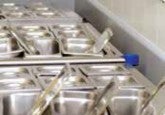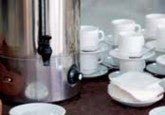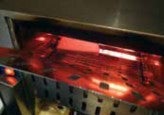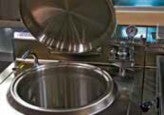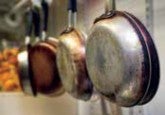Commercial gas cooking equipment cleaning and maintenance
Have gas service company representative check all burner adjustments, connections, safety controls and thermostats.
| Appliance | Inspections | Cleaning | Maintenance |
|---|---|---|---|
|
Ranges |
Accumulations of spilled food can cause corrosion, affect performance and reduce efficiency. |
Vacuuming surfaces before cleaning may remove debris before cleaning and prevent scratches. Avoid abrasive cleaners; use fine scrubbing sponges (often blue surfaces). Use vinegar and water or cleaner recommended by OEM. Only clean parts specifically labeled as dishwasher safe in dishwashers. |
Be certain surfaces are cool enough to touch before any cleaning or other maintenance is performed. Turn burner handles gently and grease with OEM recommended products. |
|
Ovens |
Burned food deposits Door alignment and seals Check for level and floor settlement issues |
Remove boil overs and spills between cooking shifts to prevent carbonizing of foods on surfaces. Clean crumbs and encrusted matter from around door opening; do not slam doors to remove debris. Follow OEM instructions for selfcleaning ovens. |
Avoid damage to thermostatic tube from caustic cleaners. |
| Broilers |
Excessive smoking Burners should have a clear flame Flames should never float |
Empty grease pan and wash with mild solution of vinegar or OEM recommended cleaner. Clean whole broiler chamber and body front with vinegar solution or OEM recommended cleaner. |
Under fired broilers require additional cleaning to prevent “over-firing” which can severely damage surfaces. Check to see that air shutters are clear. |
| Deep fat fryers |
Smoking can indicate that temperature is too high or fat has broken down. Look for accumulated food crumbs Check for gum build-up |
Drain fryer with commercial filter Wash kettle with hot alkaline solution Rinse with clear water and vinegar mixture and dry with cloth. |
When restarting after cleaning or servicing replace fat prior to lighting the gas burner to avoid flashovers. When solid fat is used set on “melt” cycle to start. |
| Griddles | Accumulated carbonized coating on surface |
Wipe frequently with heavy grease absorbent cloth. Empty and wash grease receptacle |
Regularly check thermostat operation Polish cast iron with griddle stone |
| Hot food storage tables | Inspect stainless surfaces several times each shift | Keep stainless, nickel and chrome surfaces cleaned of spills to reduce corrosion. | Check food reference guides and adjust thermostat to suit foods stored. |
| Coffee urns | Inspect between each shift for oils and deposits |
Rinse with hot water and drain. Pour two gallons of water into urn and add OEM recommended cleaner. Scrub with urn brush Rinse and drain twice |
Clean gauge glasses with gauge brush and rinse. Where faucet assemblies are designed for disassembly clean with urn solution. |
| Gas toasters | Inspect trays and air shutters for crumb deposits |
Remove trays and clean with soap solution in warm water, rinse and dry. Clean crumbs with soft brush When chain drives are used clean chains and surrounding frame. |
Lubricate chains with OEM recommended food grade grease. |
| Steam cookers | Look for food accumulations |
Clean all food compartments; remove all shelves and supports and clean out of place. Add water and mild detergent and swish with a brush; brush drain and valve with bottle brush. |
Replace gaskets when necessary Check culinary filters regularly Have operator blow down boiler to keep sediments out of “clean steam” source. |
| Tilting skillets/braisers | Look for food accumulations |
Immediately after unit is empty, turn off burners, add water and mild detergent; allow food particles to dissolve in the warm water. Swish with a brush to properly strain food receptacle. |
Maintain hinges with OEM recommended lubricants. |
Keep a record of your cooking appliances
List also names and telephone numbers of parts and servicing agencies.
| Appliance | Trade Name | Model and Serial Number | Parts and Service Contract | Phone |
|---|---|---|---|---|
| Ranges | ||||
| Ovens | ||||
| Broilers | ||||
| Deep fat fryers | ||||
| Griddles | ||||
| Hot food tables | ||||
| Coffee urns | ||||
| Gas toasters | ||||
| Steam cookers | ||||
|
Steam kettles |
||||
| Tilting braising pans | ||||
| Dishwashers |
© Copyright 2013 The Hartford Steam Boiler Inspection and Insurance Company. All Rights Reserved. Used with permission of The Hartford Steam Boiler Inspection and Insurance Company.
The recommendation(s), advice and contents of this material are provided for informational purposes only and do not purport to address every possible legal obligation, hazard, code violation, loss potential or exception to good practice. The Hanover Insurance Company and its affiliates and subsidiaries (“The Hanover”) specifically disclaim any warranty or representation that acceptance of any recommendations or advice contained herein will make any premises, property or operation safe or in compliance with any law or regulation. Under no circumstances should this material or your acceptance of any recommendations or advice contained herein be construed as establishing the existence or availability of any insurance coverage with The Hanover. By providing this information to you, The Hanover does not assume (and specifically disclaims) any duty, undertaking or responsibility to you. The decision to accept or implement any recommendation(s) or advice contained in this material must be made by you.
171-9127 (1/16) LC 2015-411



